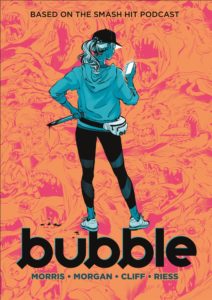Fleen Book Corner: Bubble
This book review is a bit different than most that we at Fleen run, and so I’m going to do something I pretty much never do — I’m going to tell you that we are pretty much entirely spoiler free. There’s less spoilage here than you’d get reading the blurbs in the book flaps.
Now that’s out of the way, I want to start out here by saying that if you haven’t listened to the Maximum Fun podcast Bubble, you should do that. It’s funny, it’s smart, it’s got a lot to say about unfettered capitalism and the gig economy, the voice acting is great (particularly Tavi Gevinson’s narration), and MaxFun are the audio equivalent of webcomics — they even do their merch via TopatoCo.
That said, if you listen to Bubble and then give a read to the graphic novel Bubble (story by Jordan Morris — creator of the podcast — and Sarah Morgan, with Tony Cliff on art and adaptation, and Natalie Riess providing colors), you’re not going to think it’s the same story. There’s so much missing! Characters, subplots, even the famed Laser Dong¹. It’s so very different.
And that’s okay.
Because this isn’t Bubble the podcast, it’s Bubble the graphic novel, and some things won’t fit with the page count that has to be worked with, and some things won’t work in another medium. There’s a reason why Cliff isn’t credited just for art, but for adapting one kind of story into another kind.
We don’t have tolerance for adaptation, collectively, a lot of the time. There’s a reason why I maintain that the only good Harry Potter movie is #3, because they gave it to a director with a personal vision and style and let him do a movie that was not just a straight recitation of the book. Those first two movies? You could practically hear the studio execs screaming at Chris Columbus to make the movies exactly like the books, don’t screw this up, there are billions at stake here, give the kids what they want. And he did, and they were okay, but only okay. Literalism in adaptation is creative death.
Bubble (comic form) works as a graphic novel because it was designed to be one, not a transliteration of a podcast. It’s different, and either version of the story may be your favorite, and either version may seem to be lacking in comparison. That’s okay, too, because the version you prefer is still there, waiting for you to go back to it at your leisure².
And that’s what’s key here — Morris and Morgan have brought a story that if you aren’t familiar with the podcast version, stands on its own with no problems. Cliff has constructed terrific character designs, and his environments³ and action scenes are easily the equal of anything from his Delilah Dirk series. Riess brings an aggressive normality to the color palette of Fairhaven, then kicks it into otherworldly colors during fights and time in the monster-infested Brush.
Anybody looking for an older-teens-and-up romp should pick up Bubble, but as one annoyed looking father in the story says when told that his gig workers had a pretty fun conversation about cum, Well, that’s inappropriate. We have kids. That’s actually pretty typical of the tone, so you can calibrate the ages of who you want to give the book to from that exchange.
Spam of the day:
A memory storage solution is increasingly necessary for our devices, and PhotoSave gives us everything we need. This memory pen allows us to store files from any device.
You are describing a thumb drive. You can get them at the checkout lane in the supermarket.
_______________
¹ It’s exactly what it sounds like, and it was a key enough part of the story that MaxFun made a pin.
² Alan Moore, once asked if he was upset about a movie version ruining of one of his stories pointed to the bookshelf and remarked that the story was still there.
³ Including dead-on logos for soulless corporate offerings and some really clever visual gags.

The above comments are owned by whoever posted them. The staff of Fleen are not responsible for them in any way.